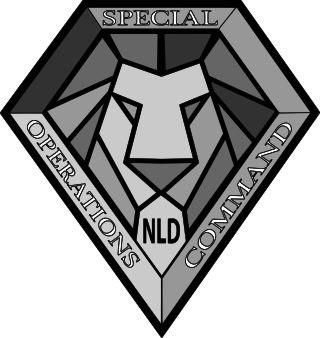
The Netherlands Armed Forces are the military services of the Kingdom of the Netherlands. The core of the armed forces consists of the four service branches: the Royal Netherlands Navy, the Royal Netherlands Army, the Royal Netherlands Air Force and the Royal Netherlands Marechaussee. The service branches are supplemented by various joint support organisations. In addition, local conscript forces exist on the Dutch Caribbean islands of Aruba (AruMil) and Curaçao (CurMil). These operate under the auspices of the Royal Netherlands Navy and the Netherlands Marine Corps. The armed forces are organisationally part of the Ministry of Defence.

The Royal Netherlands Navy is the naval force of the Kingdom of the Netherlands.

India has several Special Forces (SF) units. The three branches of the Indian Armed Forces have separate special forces units, viz. the Para SF of the Indian Army, the MARCOS of the Indian Navy and the Garud Commando Force of the Indian Air Force. There are other special forces which are not controlled by the military but operate under civilian organisations such as the Home Ministry’s National Security Guard and Research and Analysis Wing's Special Group (India). Small groups from the military SF units are deputed in the Armed Forces Special Operations Division, a unified command and control structure.

The Netherlands Marine Corps is the elite naval infantry corps of the Royal Netherlands Navy. The marines trace their origins back to the establishment of the Regiment de Marine on 10 December 1665, by the then grand pensionary of the Dutch Republic, Johan de Witt and famous Admiral Michiel de Ruyter.

The Royal Netherlands Air Force is the military aviation branch of the Netherlands Armed Forces. It was created in 1953; its ancestor, the Luchtvaartafdeling of the Dutch Army, was founded in 1913. The aerobatic display team of the Royal Netherlands Air Force, active from 1979 until 2019, was the Solo Display Team.

The Royal Netherlands Army is the land branch of the Netherlands Armed Forces. Though the Royal Netherlands Army was raised on 9 January 1814, its origins date back to 1572, when the Staatse Leger was raised making the Dutch standing army one of the oldest in the world. It fought in the Napoleonic Wars, World War II, the Indonesian War of Independence, and the Korean War and served with NATO on the Cold War frontiers in West-Germany from the 1950s to the 1990s.
The Special Emergency Response Team (SERT) was an elite police tactical unit of the Royal Canadian Mounted Police (RCMP). The SERT was formed in 1986 to provide a tactical capability to respond to major terrorist incidents throughout Canada. The unit was disbanded in 1993 when responsibility for counter terrorist response transferred from the RCMP to the Canadian Armed Forces (CAF).

Marines, or naval infantry, are typically a military force trained to operate in littoral zones in support of naval operations. Historically, tasks undertaken by marines have included helping maintain discipline and order aboard the ship, the boarding of vessels during combat or capture of prize ships, and providing manpower for raiding ashore in support of the naval objectives. In most countries, the marines are an integral part of that state's navy.

The Brigade Speciale Beveiligingsopdrachten (BSB) is the elite police tactical unit of the Royal Netherlands Marechaussee. Its missions include counter-terrorism, protection of government and military officials, and targeting organised crime.

The Dienst Speciale Interventies, commonly abbreviated DSI, is the elite police tactical unit of the Dutch National Police Corps and was formally established on 1 July 2006. The DSI is tasked with neutralising terrorist incidents and other violent public order disruptions for which regular police units are inadequately equipped. In total, the DSI consists of about 600 active personnel.

The Korps landelijke politiediensten was the national police force in the Netherlands from 1993 until 2013, responsible for specialist missions that benefited from a centralized approach.

The Marine Assault Team (MAST) (Malay: Unit Gempur Marin, Jawi: اونيت ڬمڤور مارين), formally known as the UNGERIN is a maritime counter terrorism and tactical unit of the Royal Malaysia Police's Marine Operations Force. Fully operational in 2007, the UNGERIN conducts anti-piracy and counter-terrorism operations in the coastal waters surrounding Malaysia and assists the marine police to respond swiftly.

The Korps Commandotroepen (KCT) is the elite special forces unit of the Royal Netherlands Army. The KCT traces its origins to the Second World War with the founding of No. 2 (Dutch) Troop, and the founding of the Korps Speciale Troepen during the Indonesian War of Independence. At present, the unit is tasked with conducting the full spectrum of special operations, its principal tasks being direct action, special reconnaissance, military assistance and counter-terrorism.
The National Special Operations Force (NSOF) was Malaysia's main security force which serves as the first responder to any terror threats on the country's sovereignty. The force covers elements from the Malaysian Armed Forces, Royal Malaysia Police and the Malaysian Maritime Enforcement Agency.

HNLMS Dolfijn (S808) is a Walrus-class submarine of the Royal Netherlands Navy. She entered service in 1993 as the third submarine of the Walrus class, after HNLMS Walrus and HNLMS Zeeleeuw. Dolfijn has been deployed both for naval exercises and in combat operations around the world. Furthermore, the submarine plays an important role by performing intelligence operations.

The Netherlands Maritime Special Operations Forces is the special forces unit of the Marine Corps of the Royal Netherlands Navy. It is one of the three principal units tasked with special operations in the Netherlands. The unit can be deployed worldwide to conduct special operations, including counter-terrorism both overseas and domestically, with a maritime focus. Its operations are planned and coordinated by the Netherlands Special Operations Command, as are the operations of the KCT.

The Netherlands Special Operations Command is a joint command of the Netherlands Armed Forces which is responsible for the planning, command and control, execution and evaluation of all operations conducted by the Dutch special operations forces, the Korps Commandotroepen (KCT) and the Netherlands Maritime Special Operations Forces (NLMARSOF).





















